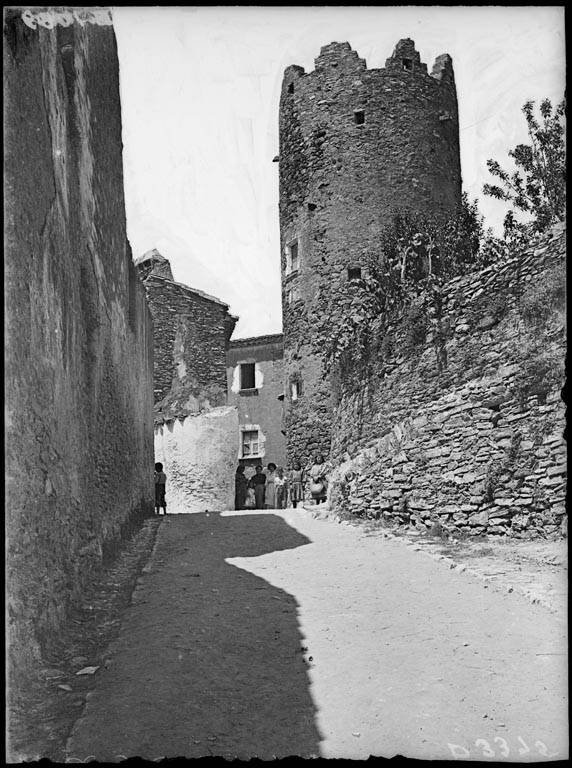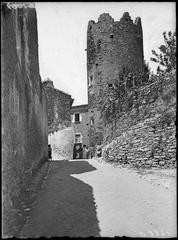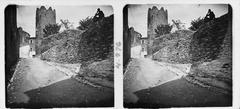
Torre De Can Marquès: Visiting Hours, Tickets, and Comprehensive Guide to Begur’s Historical Heritage
Date: 14/06/2025
Introduction: Torre De Can Marquès and Its Significance
In the heart of Begur, Catalonia, the Torre de Can Marquès stands as a testament to the region’s history of maritime defense and local resilience. Built between the 16th and 17th centuries, during a period of intense Berber pirate activity, this circular stone tower formed a crucial part of a broader coastal defense network. Commissioned under the rule of King Charles I of Spain, the tower’s robust masonry, narrow loopholes, and strategic urban placement reflect the ingenuity and urgency of its era (MonumentalNet; Catalunya Medieval).
Over time, as Begur transformed into a peaceful town, the tower was incorporated into a 19th-century masía (farmhouse), symbolizing the area’s evolution from a defensive outpost to a cultural and tourist destination (visitbegur.cat; Catalunya Turisme). Though privately owned and generally not open for interior visits, Torre de Can Marquès remains a compelling landmark, offering visitors a tangible connection to Begur’s defensive past.
This in-depth guide provides historical background, practical visitor information—including current visiting hours, ticket policies, accessibility, and travel tips—as well as recommendations for exploring Begur’s rich tapestry of heritage sites.
Historical Context: Mediterranean Piracy and Coastal Defenses
During the 16th century, Catalonia’s Mediterranean coastline was under frequent threat from Berber pirates, who launched raids from North Africa, looting settlements and taking captives (MonumentalNet). The rise of Ottoman power in North Africa, particularly after the conquest of Algiers in 1516, spurred King Charles I of Spain to implement a network of watchtowers and fortified structures along the coast, aimed at providing early warnings and communal refuge (MonumentalNet).
Construction and Architectural Features
Period and Purpose
Built between the 16th and 17th centuries, Torre de Can Marquès reflects the era’s strategic need for vigilant coastal defense (Catalunya Medieval). These towers enabled visual communication using smoke or fire signals, creating a network of early-warning systems.
Location and Structure
Situated on Frederic Sirés i Puig alley, adjacent to Bonaventura Carreras street in Begur’s old town, the tower’s placement maximized its defensive and surveillance capabilities (MonumentalNet). The structure stands about 12 meters tall and 5 meters in diameter, with thick stone walls, narrow loopholes for observation and defense, and a circular plan to reduce blind spots (MonumentalNet).
Adaptive Reuse
In the 19th century, the tower was integrated into a residential masía, a common fate for many such towers as pirate threats diminished (MonumentalNet). The tower’s thick exposed stonework and distinctive silhouette remain visible from the street.
Defensive Features
- Thick masonry walls (over 1 meter) for protection
- Loopholes for weapons and surveillance
- Elevated or restricted entry points to hinder attackers
- Rooftop terrace for panoramic surveillance and as a final defensive position
Begur’s Defensive Network
Begur once featured up to ten similar towers, with six surviving today (MonumentalNet). These formed an integrated system:
- Visual communication: Line-of-sight with other towers and Begur Castle
- Community refuge: Safe haven for townspeople during raids
- Complementary defenses: Worked in conjunction with the main castle
Notable nearby towers include Torre de Ca n’Armanac and Torre dels Encantats.
Visiting Torre de Can Marquès: Essential Information
Visiting Hours and Ticket Information
- Interior Access: The tower is privately owned and not open for regular interior visits.
- Exterior Viewing: The upper section is visible from Carrer Bonaventura Carreras and can be viewed freely at any time (Pobles de Catalunya).
- Guided Tours: Occasionally, Begur’s tourist office or cultural events include guided walking tours incorporating Torre de Can Marquès and other towers. Check for scheduled events or special openings (visitbegur.cat).
Accessibility
The narrow, cobbled streets and uneven surfaces of Begur’s historic center can be challenging for those with reduced mobility.
Getting There
Begur is accessible by car from Girona (45 min) and Barcelona (2 hours), with public buses from nearby towns. Parking in the old center is limited, but shuttle buses connect the center with major coves during peak season (Unexpected Catalonia).
Travel Tips for Visiting Begur
- Best time to visit: Spring (April–June) and early autumn (September–October) for pleasant weather and fewer crowds.
- Getting around: Explore the historic center and defensive towers on foot; use the shuttle for beach access.
- Local events: The Fira d’Indians and Begur Music Festival feature the tower as a backdrop (Catalunya Turisme).
- Photography: Early morning or late afternoon is best for photos.
Nearby Attractions and Activities
Begur Castle
The castle ruins, dating to the 11th century, provide panoramic views of the Costa Brava and neighboring towns (Catalunya Turisme).
Other Defensive Towers
Many defensive towers are within easy walking distance, including Torre Hermanac de Can Pi and Torre del Mas Pinc (Visit Begur).
Historic Town Center
Explore the Church of Sant Pere, Indiano mansions, and lively squares (Cocotran).
Beaches and Coastal Walks
Enjoy nearby coves such as Aiguablava, Sa Tuna, and Sa Riera, or hike along the Camí de Ronda coastal trail (Trip101).
Dining and Shopping
The center offers traditional Catalan cuisine, tapas, seafood, and local markets. Boutiques sell artisanal goods and regional specialties (Cocotran).
Day Trips
Visit medieval villages like Esclanyà and Pals for additional historical charm (Catalunya Turisme).
Visitor Experience and Preservation
Torre de Can Marquès, declared a historic-artistic monument in 1944, is protected as a cultural heritage site. Respectful visitation ensures the preservation of its unique architecture and historical significance for future generations (Wikipedia).
Frequently Asked Questions (FAQ)
Q: Can I enter Torre de Can Marquès?
A: Regular interior access is not available due to private ownership. The exterior is visible at any time.
Q: Are guided tours available?
A: Yes, check with Begur’s tourist office for periodic guided walks or special events.
Q: Is there an entrance fee?
A: No fee is required to view the exterior. Guided tours are typically free or low-cost.
Q: Is the area accessible for those with reduced mobility?
A: Historic cobbled streets may pose challenges.
Q: What other sites should I visit in Begur?
A: Begur Castle, other defensive towers, the old town, beaches, and nearby villages.
Summary and Travel Planning
Torre de Can Marquès encapsulates Begur’s legacy of resilience and strategic defense, standing as part of a notable network of medieval towers. While interior access is limited, the exterior offers a striking historical presence, complemented by nearby attractions, guided tours, and seasonal events (MonumentalNet; visitbegur.cat). Planning a visit in spring or early autumn, leveraging local resources, and respecting preservation guidelines will make for a rewarding cultural experience.
Official Sources and Further Reading
- MonumentalNet
- Catalunya Medieval
- visitbegur.cat
- Catalunya Turisme
- Pobles de Catalunya
- Unexpected Catalonia


